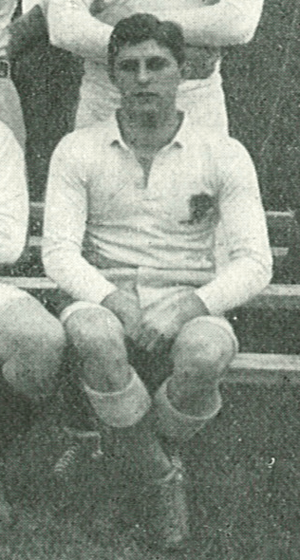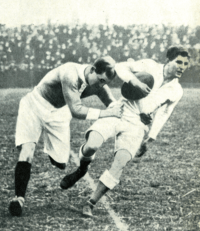Cyril Lowe facts for kids
 |
|||||||||||||||||||||||||||||
| Birth name | Cyril Lowe | ||||||||||||||||||||||||||||
|---|---|---|---|---|---|---|---|---|---|---|---|---|---|---|---|---|---|---|---|---|---|---|---|---|---|---|---|---|---|
| Date of birth | 7 October 1891 | ||||||||||||||||||||||||||||
| Place of birth | Holbeach, Lincolnshire, England | ||||||||||||||||||||||||||||
| Date of death | 6 February 1983 (aged 91) | ||||||||||||||||||||||||||||
| School | Dulwich College | ||||||||||||||||||||||||||||
| University | Cambridge University | ||||||||||||||||||||||||||||
| Rugby union career | |||||||||||||||||||||||||||||
|
|||||||||||||||||||||||||||||
| Military career | |||||||||||||||||||||||||||||
| Allegiance | United Kingdom | ||||||||||||||||||||||||||||
| Service/ |
British Army Royal Air Force |
||||||||||||||||||||||||||||
| Years of service | 1914–1919 1921–1944 |
||||||||||||||||||||||||||||
| Rank | Group Captain | ||||||||||||||||||||||||||||
| Unit |
|
||||||||||||||||||||||||||||
| Commands held |
|
||||||||||||||||||||||||||||
| Battles/wars | World War I World War II | ||||||||||||||||||||||||||||
| Awards | Military Cross Distinguished Flying Cross |
||||||||||||||||||||||||||||
Cyril Nelson "Kit" Lowe (born October 7, 1891 – died February 6, 1983) was an amazing English rugby union player. He held England's record for scoring the most tries in international games for over 60 years! He was also a brave First World War pilot, known as a "flying ace," with nine victories. Some people even say he was the inspiration for the famous book character "Biggles".
Contents
Early Life and School
Cyril Lowe was born in Holbeach, a town in Lincolnshire, England. He went to Dulwich College, a boarding school. He was very good at many sports there, including boxing, athletics, swimming, cricket, and rugby.
In 1911, he was the captain of the athletics team. He also played for the school's main cricket team. He played alongside future famous cricketers like Arthur Gilligan, who would later captain the England team.
But rugby was where he really shined! He played for the school's top rugby team from 1908. In 1909, his team was unbeaten. This team had five players who would later play for their countries. They were called the 'Famous Five'. Cyril Lowe was one of them. He even captained the school's rugby team in 1910–11.
Even though he was a great athlete, Lowe wasn't very big. He was about 5 feet 8 inches tall and weighed around 133 pounds. Because he was small, his school nickname was "Tich" Lowe.
After school, he went to Cambridge University. He continued to play rugby there and was a top player.
Rugby Career Highlights
Cyril Lowe started playing for the England rugby team in 1913 while still at Cambridge. His international career lasted through the First World War. He scored an amazing 18 tries in 25 international matches. He was on the losing side only three times!
He helped England win the Grand Slam four times before he retired in 1923. A Grand Slam means winning every game in the Five Nations Championship. In 1914, he scored eight tries in the Championship. This is still a record, only matched by one other player.
After university, Lowe played for Blackheath. He also represented the Royal Air Force on the Rugby Union Committee.
The First World War stopped his rugby career for a few years. He didn't play for England again until 1920. He retired from international rugby in 1923. His record of 18 tries for England lasted for 66 years! Another Royal Air Force pilot, Rory Underwood, finally broke his record in 1989.
International Tries
Here is a list of the tries Cyril Lowe scored for England:
| Try | Opposing team | Location | Venue | Competition | Date | Result |
|---|---|---|---|---|---|---|
| 1 | Twickenham, England | Twickenham | Five Nations Championship | 14 February 1914 | Won | |
| 2 | Twickenham, England | Twickenham | Five Nations Championship | 14 February 1914 | Won | |
| 3 | Inverleith, Scotland | Inverleith | Five Nations Championship | 21 March 1914 | Won | |
| 4 | Inverleith, Scotland | Inverleith | Five Nations Championship | 21 March 1914 | Won | |
| 5 | Inverleith, Scotland | Inverleith | Five Nations Championship | 21 March 1914 | Won | |
| 6 | Colombes near Paris, France | Colombes Stadium | Five Nations Championship | 13 April 1914 | Won | |
| 7 | Colombes near Paris, France | Colombes Stadium | Five Nations Championship | 13 April 1914 | Won | |
| 8 | Colombes near Paris, France | Colombes Stadium | Five Nations Championship | 13 April 1914 | Won | |
| 9 | Dublin, Ireland | Lansdowne Road | Five Nations Championship | 14 February 1920 | Won | |
| 10 | Twickenham, England | Twickenham | Five Nations Championship | 20 March 1920 | Won | |
| 11 | Twickenham, England | Twickenham | Five Nations Championship | 15 January 1921 | Won | |
| 12 | Twickenham, England | Twickenham | Five Nations Championship | 12 February 1921 | Won | |
| 13 | Colombes near Paris, France | Colombes Stadium | Five Nations Championship | 28 March 1921 | Won | |
| 14 | Cardiff, Wales | Cardiff Arms Park | Five Nations Championship | 21 January 1922 | Lost | |
| 15 | Dublin, Ireland | Lansdowne Road | Five Nations Championship | 11 February 1922 | Won | |
| 16 | Twickenham, England | Twickenham | Five Nations Championship | 18 March 1922 | Won | |
| 17 | Twickenham, England | Twickenham | Five Nations Championship | 18 March 1922 | Won | |
| 18 | Leicester, England | Welford Road Stadium | Five Nations Championship | 10 February 1923 | Won |
Military Service
First World War Hero
When the First World War began in 1914, Cyril Lowe joined the army. He became an officer in the Royal Army Service Corps. Later, he transferred to the Royal Flying Corps, which was the air force at the time.
He became a pilot and was part of No. 11 Squadron. He flew a plane called an F.E.2b. On March 15, 1917, he got his first victory, destroying an enemy aircraft. He continued to fly bravely.
In 1918, he joined No. 24 Squadron and flew a faster plane called an S.E.5a. Between April and July 1918, he achieved seven more victories. This brought his total to nine enemy planes destroyed or forced down. This made him a "flying ace."
For his bravery, Lowe received two important awards:
- The Distinguished Flying Cross (DFC) in August 1918. This award is for courage while flying.
- The Military Cross (MC) in September 1918. This award is for bravery during battle.
His award citations described his amazing courage. For example, he once attacked 26 enemy planes with only one working gun! Another time, his plane was on fire, but he still helped a fellow pilot.
After the War
After the First World War ended, Lowe left the Royal Air Force (RAF) in 1919. However, he returned to the RAF in 1921. He continued to serve and was promoted over the years.
He became a squadron leader in 1925. He commanded different squadrons, including No. 602 City of Glasgow Squadron and No. 1 Squadron in Iraq.
By 1928, he was commanding No. 43 Squadron in England. This squadron became famous for their amazing aerobatic displays (fancy flying tricks!).
Lowe was promoted to wing commander in 1933. He became the chief instructor for the Oxford University Air Squadron. He retired from the RAF as a group captain in 1944.
Cyril Lowe passed away in 1983 at the age of 91. He is remembered as a great rugby player and a brave pilot.
See also
- List of top English points scorers and try scorers


